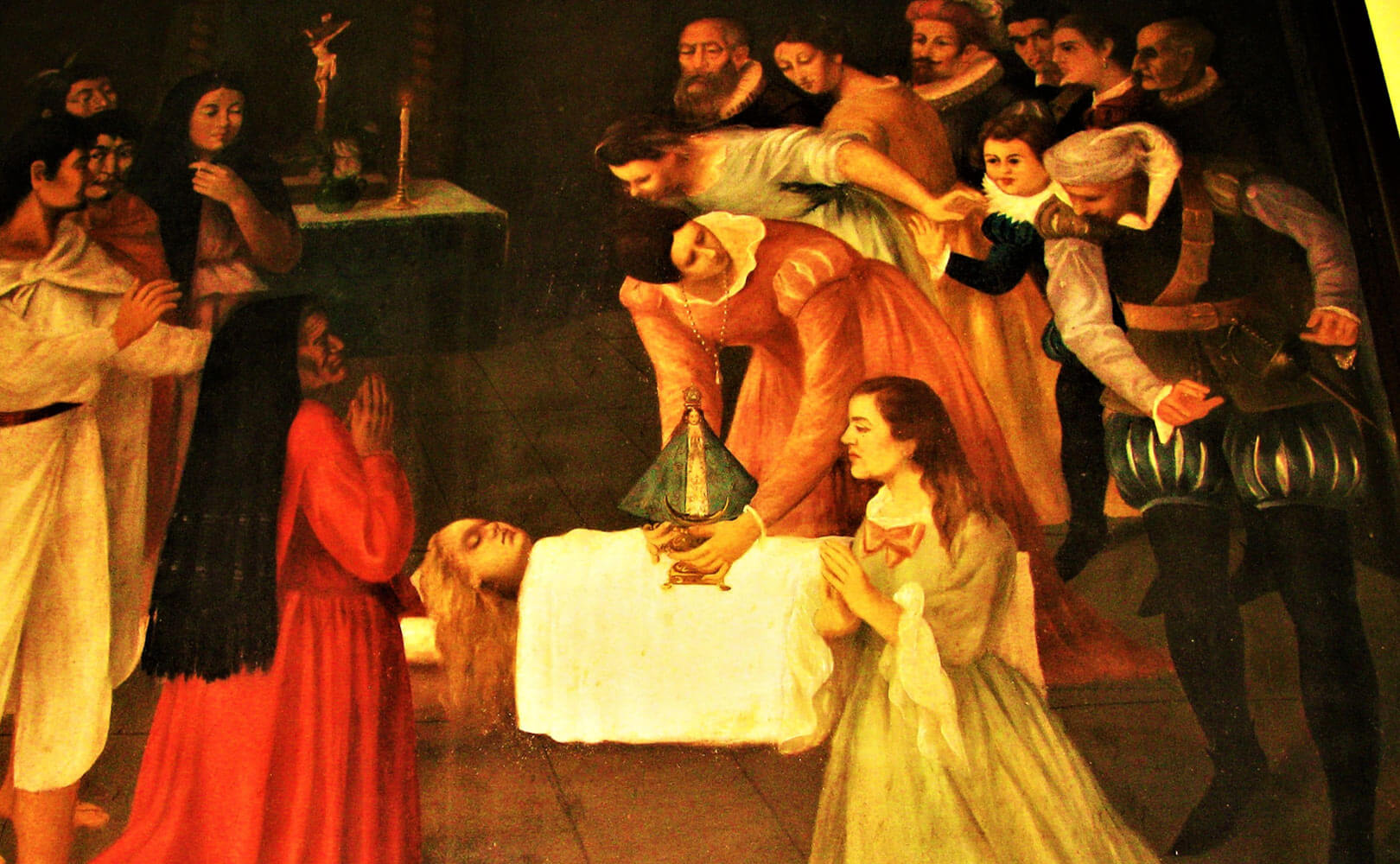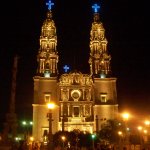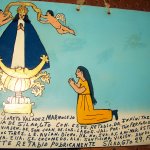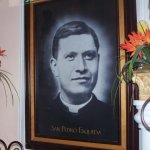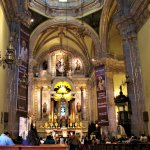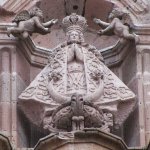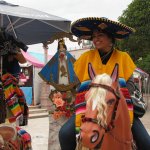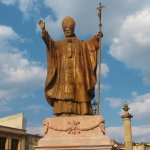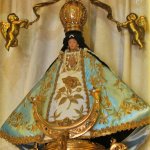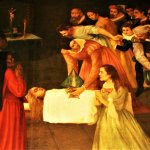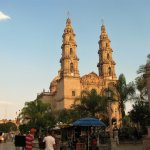Who doesn’t love a circus? The acrobats. The clowns. The trapeze artists. And the inhabitants of San Juan de los Lagos in the state of Jalisco were no exception. They were abuzz with excitement. The circus was coming to town!
The year was 1623. A family of trapeze artists had just arrived in town, en route to Gaudalajara. The star of the entourage was a six-year-old girl. The audience marveled at her performance on the high-wire. She seemed to glide through the air like a bird! Like a tiny ballerina with wings. The spectators were dazzled by it all and couldn’t stop applauding.
To increase the thrill factor, daggers, instead of a safety net, had been placed in the ground with their points positioned upward. All was going perfectly until the child attempted a risky maneuver. And then the unthinkable happened. The little girl lost her footing and plunged to the ground, impaled by a dagger which pierced her heart. The crowd gasped in horror. And sorrow swept through the audience like a tsunami. The little trapeze artist died instantly.
But then, a while later, something happened: A commotion was heard. What was going on? A woman was barreling her way through the crowd. “Wait! Don’t bury the child! I have the remedy,” said 78-year-old Ana Lucia in a firm voice. She was carrying a small, somewhat shabby statue of the Madonna in her arms. “Don’t be ridiculous, Ana Lucia!” bellowed a skeptic. “The child has been dead for hours!” Ignoring him, Ana Luisa placed the statue on the little corpse. Within minutes the faintest of stirrings rippled across the burial cloths. The crowd stared spellbound. Rapt. The girl’s hands began trembling. To the astonishment of all the young performer sat upright and opened her eyes. She was alive! The crowd went wild with cheering and yelling and rejoicing.
Word of the great miracle spread and pilgrims came running from everywhere to see the miraculous statue. And they have never stopped coming.
But to step back for a bit: one must wonder why the statue of Our Lady had become so unsightly: The reason, first of all, is its antiquity. Franciscan Friar Venerable Miguel Bolonia had brought the exquisite statue to the town in 1542. He had ordered it from the Tarascan Indians of Patzcuaro, Michoacan, who were renowned throughout the country for the sculpting of religious images. They had developed a compound known as pasta de Michoacan, a mixture of cornstalk glue and orchid bulbs, which formed a lightweight and malleable substance, ideal for their purposes.
The diminutive statue (it is slightly over a foot in height) was housed in a humble adobe, grass-roofed, chapel. Pedro Antes and his wife, Ana Luisa, were the chapel’s caretakers. Ana was particularly devoted to the statue of Our Lady and called it Cihuapilli (“Lady”). Over time, however, the statue’s face became blackened and disfigured by insects and the elements. By 1623, the statue was no longer the exquisite image it had been—it had become tattered and disheveled. But this was soon to change!
After the miracle of 1623, the acrobat’s father was so immensely grateful to the Virgin that he asked permission to take the statue to Guadalajara to be restored. The pastor, Don Diego Camerena, gave his permission for the undertaking. When the father arrived in the city he was met by two handsome strangers who approached him: “Are you looking for an artist to repair a sacred image?” they asked. “If so, we are at your service.” In a short time the statue was “beautifully restored” and the artists vanished, without asking for any payment. No one has ever discovered the identity of the two “mystery” artists.
Who were they? “Well, of course they were angels,” explained Ana Luisa, who lived to be 110 years old.
Today, defying all scientific explanation, the statue is in pristine condition. Like the tilma of Juan Diego, the statue should have disintegrated into a powder-like substance in a few short years. Instead, after four centuries, it is intact and robust.
An investigation by ecclesiastical authorities in 1634, 1639, and 1668, verified the authenticity of the 1623 miracle as well as a “multitude of miracles performed by Our Lady by means of her image of San Juan de los Lagos.”
These miracles are continuing to the present day. Beside the sanctuary is a sala (a room) which gives evidence of “an uninterrupted series of favours and miracles.” Its walls are covered with testimonials of thanksgiving from grateful recipients. We read about Adriana Bastida, who thanked our Lady on May 21, 2006; she fell and fractured her cranium and is “all cured.” And also about Margarita Perez from San Felipe, who thanked Our Lady in December 2005 for curing her sick husband.
Today the shrine is the second most visited church in Mexico, after Our Lady of Guadalupe. The original little adobe chapel is no more. In its place is a magnificent Baroque cathedral-basilica which is home to four large paintings by the 17th century Flemish master, Peter Paul Rubens.
The basilica has received the approval of the church at its highest levels: In 1904 the statue was solemnly crowned with the authorization of Pope St. Pius X. In 1923, the church was raised to the level of a Collegiate church by a Papal Bull of Pope Pius XI, and in 1947 Pope Pius XII elevated the sanctuary to the category of a minor basilica.
Probably the greatest honour of all accorded to the statue occurred on May 8, 1990: Pope St. John Paul ll visited the shrine on that day. He was so moved by the image that he spent three minutes before the statue in a spirit of “intense recollection.” As he was exiting from her presence, he turned back (as if he couldn’t tear himself away) and spent an additional “120 seconds” in prayer before the revered image.
No stranger to religious persecution, under the Nazis and the Communists, Pope St. John Paul ll would have been acutely aware of the persecution in Mexico. San Juan de los Lagos, as did all of Mexico, suffered during the fierce, anti-Catholic revolution of the 1920’s. According to Graham Greene, in his book, The Lawless Roads, “It was a time when every priest was hunted down or shot.”
One of those who suffered grievously was the martyr San Pedro Esqueda Ramirez (1887-1927), who was born in the town. As the pastor of the nearby St. John the Baptist church (just steps away from the Cathedral-Basilica), he had a fervent passion for Eucharistic Adoration, Our Lady (particularly in her title as Nuestra Senora de San Juan de los Lagos), and the catechesis of children. As a young priest, he had founded a school for the training of catechists.
He was taken prisoner by the revolutionary soldiers and beaten, scourged and bludgeoned for four days. “Deny Christ! Deny your priesthood! Then we will let you go!” “Never! Never!” answered the saint. He was shot to death by a soldier on Nov. 22, 1927 and was canonized by Pope St. John Paul ll in 2000.
In those days in Mexico we saw a disturbingly familiar chronology:
First they came for the statues: “The statues were carried out of the church while the inhabitants watched, sheepishly, and saw their children encouraged to chop up the images in return for little presents of candy.” (The Lawless Roads)
Then they came for the churches: “They went to the cathedral—and sprayed it with gasoline and bombs were set—and the imposingly massive structure—was badly damaged.” (Mexican Martyrdom by Fr. Wilfrid Parsons, S.J.)
And then they came for the priests.
Our Lady of San Juan de los Lagos, St. Pedro Esquada, Please pray for our priests!

